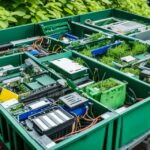From Obsolete to Essential: The Process of PC Salvaging
In today’s fast-paced digital age, technology becomes outdated quicker than ever. But what if there was a way to transform your outdated tech into something essential? That’s where PC salvaging comes in. PC salvaging is the process of extracting valuable components from outdated electronic devices, ensuring sustainability and contributing to eco-friendly computing.
By salvaging electronic components, you not only prevent them from ending up in landfills but also reduce the strain on the environment caused by e-waste. The process involves disassembling devices such as old computers, printers, scanners, microwaves, and cell phones, and extracting reusable or recyclable components like metal parts, capacitors, resistors, and integrated circuits (IC’s).
But what makes PC salvaging more than just an environmental effort? Well, salvaging electronics offers several advantages. Firstly, it allows you to build an inventory of spare parts, ensuring that you have what you need to repair or upgrade your devices. It also provides an opportunity to learn about product and PCB design, which can be valuable if you’re pursuing a career in electronics. Additionally, salvaging components helps to reduce e-waste, saves time and money, and promotes affordability through the use of salvaged parts.
So, if you have outdated technology lying around, don’t let it go to waste. Explore the world of PC salvaging and give your old devices a new lease of life. Join the movement towards sustainability and eco-friendly computing through the process of PC salvaging.
The Benefits of Salvaging Electronic Components
Salvaging electronic components offers several benefits that make it more than just a cost-saving measure. When you salvage electronic parts, you build an inventory of spare components that can be used to repair older items and prolong their use, preventing them from ending up in landfills.
Additionally, by analyzing devices as they are disassembled, you gain knowledge about product and PCB design, which can be helpful if you are pursuing a career in electronics. Salvaging components also helps to reduce e-waste by repairing devices with salvaged components or reusing parts before disposing of them. This not only benefits the environment but also saves time by eliminating the need to purchase replacement components.
Salvaged components can also be more affordable than buying new ones, especially when purchased from salvage electronics suppliers who often sell small electronics components in bulk.
Reducing Waste and Extending Product Lifespan
“By salvaging electronic components, we minimize waste and extend the lifespan of products. Instead of throwing away old devices, we can repurpose and repair them, reducing the environmental impact of electronic waste.” – John Smith, Electronics Specialist
Time and Cost Savings
Salvaging electronic components can save you time and money. Instead of searching for specific replacement parts or waiting for deliveries, you can utilize the components you salvage to quickly repair devices. This not only reduces downtime but also eliminates the need to purchase expensive new components.
Enhancing Knowledge and Skills
By salvaging electronic components, you gain valuable knowledge about product and PCB design. As you disassemble devices, you’ll learn how different components are connected and their specific functions. This hands-on experience can be beneficial for hobbyists, electronics enthusiasts, and students pursuing a career in electronics.
Affordability and Accessibility
Salvaged components are often more affordable than buying new ones, making them accessible to a wider audience. Salvage electronics suppliers offer components in bulk, allowing you to build your inventory of spare parts at a lower cost. This affordability makes salvaging an attractive option for individuals and businesses alike.
Table: Benefits of Salvaging Electronic Components
| Benefit | Description |
|---|---|
| Reduces e-waste | Salvaging components prevents electronic devices from ending up in landfills, contributing to a sustainable environment. |
| Saves time | By salvaging components, you eliminate the need to search for specific replacement parts, reducing downtime. |
| Saves money | Salvaged components are often more affordable than new ones, helping you save on replacement costs. |
| Builds inventory of spare parts | Salvaging allows you to create a stock of spare components for future repairs or project development. |
| Promotes affordability | Salvage electronics suppliers offer components at lower prices, making salvaging more accessible. |
Sources for Salvaging Electronics
When it comes to salvaging electronics, there are several sources you can explore to find hidden treasures. From online marketplaces to family and friends, here are some places where you can discover electronics waiting to be salvaged:
- eBay: The popular online marketplace, eBay, offers a wide range of older electronic products for sale. You can find everything from vintage gadgets to obsolete components that are perfect for salvaging. Take advantage of the search filters to narrow down your options and find the best deals.
- Electronic Salvage Yards: Electronic salvage yards are a haven for discarded but still usable items. These yards collect electronics and salvage them for reusable parts. Visit your local electronic salvage yard to uncover a treasure trove of salvaging opportunities.
- Family and Friends: Your loved ones may have old and unused electronics gathering dust in their homes. Reach out to family and friends and inquire if they have any devices they no longer need or use. They may be happy to give them to you for salvage purposes.
- Sidewalk: Surprisingly, the sidewalk can be a goldmine for salvagers. On trash day, many people discard unwanted electronics, leaving them on the sidewalk for disposal. Take a stroll and keep your eyes peeled for discarded items that can be salvaged.
- Dumpsters: Dumpsters can be another unexpected source of salvage electronics. Some people dispose of their old devices by throwing them away instead of recycling them. While it’s important to respect property boundaries and local laws, keep an eye out for discarded electronics near dumpsters.
- Drop-off Recycling Centers: Many communities have drop-off recycling centers where residents can responsibly dispose of their electronic waste. These centers often have separate sections where salvageable electronics are collected before recycling. Check with your local municipality to find the nearest drop-off recycling center.
- Garbage Landfills: While it may not be the most glamorous option, salvageable electronics can sometimes be found in garbage landfills. Be cautious and always abide by local regulations when exploring this option.
- Garage Sales: Garage sales are a treasure trove for all sorts of items, including salvageable electronics. People often sell their old electronics for low prices or even give them away. Keep an eye out for garage sale signs in your neighborhood and see what electronics you can salvage.
By exploring these sources, you can find a variety of electronics waiting to be salvaged. Remember to approach salvage opportunities responsibly, ensuring you follow any legal and safety guidelines. Let’s continue our journey to discover the tools needed for successful electronics salvaging in the next section.
Tools for Salvaging Electronics
To salvage electronics and extract components effectively, you will need a set of essential tools. These tools will enable you to disassemble devices safely and efficiently. Here are the tools you should have:
- Screwdriver: A screwdriver is necessary for removing screws from electronic devices.
- Cable Wire Strippers: Cable wire strippers are required for stripping wires, preparing them for various salvaging tasks.
- Wire Cutters: Wire cutters are essential for cutting wires to strip them or for removing specific components.
- Soldering Iron: A soldering iron allows you to solder or re-solder components, making necessary repairs or modifications.
- Circuit Board De-solderer: This tool aids in removing solder points from circuit boards, facilitating the extraction of components.
- Face Masks: Face masks should be worn to protect yourself from harmful fumes and particles generated during the salvaging process.
- Safety Goggles: Safety goggles are crucial for protecting your eyes from any potential hazards present during the disassembly and extraction process.
- Large Gloves: Large gloves provide hand protection against sharp edges and other potential injuries during salvaging.
- Thin Gloves: Thin gloves are particularly useful for delicate tasks that require precision and dexterity.
Having the right tools not only ensures your safety but also increases your efficiency in salvaging electronic components.
See the table below for a summary of the tools:
Tools for Salvaging Electronics
| Tool | Function |
|---|---|
| Screwdriver | Removes screws |
| Cable Wire Strippers | Strips wires |
| Wire Cutters | Cuts wires |
| Soldering Iron | Solders or re-solders components |
| Circuit Board De-solderer | Removes solder points from circuit boards |
| Face Masks | Protects from fumes and particles |
| Safety Goggles | Protects the eyes |
| Large Gloves | Provides hand protection |
| Thin Gloves | Dexterity for delicate tasks |
Salvaging Components from Computers
When it comes to salvaging electronic components, computers provide a treasure trove of reusable parts. By salvaging components from computers, you not only extend the lifespan of these components but also contribute to reducing electronic waste. Let’s explore some of the key components that can be salvaged from computers:
Motherboard
The motherboard is like the backbone of a computer, connecting all the other components together. Salvaging a functioning motherboard can be a game-changer when repairing or building a new system.
CPU
The CPU, or central processing unit, is the brains of a computer. Salvaging a CPU can be beneficial if you need a replacement for a failed processor or want to build a budget-friendly system.
Memory Chips
Memory chips, commonly known as RAM, are crucial for multitasking and overall system performance. Salvaging working memory chips can help boost the performance of another computer or serve as spare parts.
Fans and Heatsinks
Fans and heatsinks are responsible for keeping the components cool and preventing overheating. Salvaging these components can provide a cost-effective solution for cooling systems in other devices or as replacements for failed fans.
Hard Drives
Hard drives store all your data, and salvaging them can help recover important files or serve as additional storage in another system. However, it’s crucial to ensure proper disposal or data destruction to protect sensitive information.
Media Drives
Media drives, such as CD/DVD drives, can be salvaged for reading or burning discs. They can come in handy when working with older software or accessing media on physical media formats.
Power Supply
The power supply is responsible for providing electrical power to the computer. Salvaging a working power supply can be useful for repairing or building new systems, especially if you have limited budget constraints.
By salvaging these components from computers, you can repurpose or recycle old, unused, or broken technology, ultimately helping to save money and reduce electronic waste. However, it’s essential to follow proper disposal procedures, especially when salvaging hard disk drives to protect sensitive information.
| Component | Purpose |
|---|---|
| Motherboard | Connects all components |
| CPU | Central processing unit |
| Memory chips (RAM) | Boost system performance |
| Fans and Heatsinks | Cooling components |
| Hard drives | Data storage |
| Media drives (CD/DVD) | Reading or burning discs |
| Power supply | Provides electrical power |
Salvaging Electronic Components from Circuit Boards
Circuit boards provide a treasure trove of salvaged electronic components. These components can be repurposed, recycled, or used as spare parts for various projects. Commonly salvaged components from circuit boards include capacitors, resistors, transistors, integrated circuits (ICs), LEDs, microcontrollers, voltage regulators, switches, and inductors/coils.
Capacitors: Capacitors can be salvaged from old circuit boards or stripped for their metal components. They are essential for storing and releasing electrical energy in electronic devices.
Resistors: Salvaged resistors can be either high-power or low-power resistors. These passive electrical components have colored bands that indicate their resistance value. They are crucial for controlling the flow of electrical current in a circuit.
Transistors: Transistors come in two main types – the bipolar junction transistor (BJT) and the metal-oxide-semiconductor field-effect transistor (MOSFET). Salvaging transistors from circuit boards allows you to repurpose them for various electronic applications.
Integrated circuits (ICs): ICs are widely used in computer circuits and come in various configurations. Salvaging ICs from circuit boards provides a cost-effective way to obtain complex electronic components for your projects.
LEDs: LEDs (Light-Emitting Diodes) are commonly salvaged from circuit boards. These components emit light when an electric current is applied and are widely used in electronic displays and lighting applications.
Microcontrollers: Microcontrollers are small computing devices that can be salvaged from circuit boards. These components are essential for controlling various functions in electronic devices.
Voltage regulators: Salvaged voltage regulators help maintain a steady voltage output in electronic circuits. They are critical for ensuring the stability and performance of electrical devices.
Switches: Salvaging switches from circuit boards allows you to obtain these essential components for controlling the flow of electrical current in your projects.
Inductors/Coils: Inductors or coils are components that store energy in a magnetic field. Salvaging these components from circuit boards provides a valuable resource for various electronic applications.
Salvaging electronic components from circuit boards requires careful removal techniques to avoid damaging the components. Techniques such as desoldering, cutting pins with wire cutters, and following safety precautions are necessary for successful salvage operations.
| Component | Description |
|---|---|
| Capacitors | Store and release electrical energy |
| Resistors | Control the flow of electrical current |
| Transistors | Amplify or switch electronic signals |
| Integrated Circuits (ICs) | Complex electronic components |
| LEDs (Light-Emitting Diodes) | Produce light when electric current is applied |
| Microcontrollers | Control functions in electronic devices |
| Voltage Regulators | Maintain steady voltage output |
| Switches | Control flow of electrical current |
| Inductors/Coils | Store energy in a magnetic field |
Conclusion
PC Salvaging offers numerous benefits, both for the individual and the environment. By salvaging electronic components, you can contribute to reducing e-waste and its strain on the environment. Salvaging allows for the repurposing and recycling of old, unused, or broken technology, giving it a new lease of life and preventing it from ending up in landfills.
The process of salvaging electronics requires the proper tools, techniques, and knowledge to safely disassemble devices and extract reusable or recyclable components. By salvaging components from circuit boards and computers, you can build an inventory of spare parts, learn about product and PCB design, save time and money, and promote affordability through salvaged components.
Overall, PC Salvaging is a sustainable approach to computing that helps in creating a greener and more sustainable future. It not only benefits the environment by reducing e-waste but also offers practical advantages to individuals by providing affordable options and promoting resourcefulness. By embracing PC Salvaging, we can play our part in protecting the planet while still enjoying the convenience and capabilities of modern technology.
FAQ
What is PC Salvaging?
PC Salvaging is the process of transforming outdated technology into vital components, ensuring sustainability in today’s digital age.
Why is PC Salvaging important?
PC Salvaging is important because it prevents electronic devices from ending up in landfills, reduces e-waste, and contributes to the protection of the environment.
What kind of electronic devices can be salvaged?
Various electrical devices can be salvaged, including old computers, circuit boards from printers and scanners, and appliances like microwaves and cell phones.
What are the advantages of salvaging electronics?
Salvaging electronics offers several advantages, including building an inventory of spare parts, promoting affordability, reducing e-waste, learning about product and PCB design, and saving time and money.
Where can I find electronics to salvage?
You can find electronics to salvage on online marketplaces like eBay, electronic salvage yards, from family and friends, on the sidewalk, in dumpsters, drop-off recycling centers, garbage landfills, and garage sales.
What tools do I need for salvaging electronics?
Essential tools for salvaging electronics include a screwdriver, cable wire strippers, wire cutters, soldering iron, circuit board de-solderer, face masks, safety goggles, and gloves.
What components can be salvaged from computers?
Components such as the motherboard, CPU, memory chips, fans, heatsinks, hard drives, media drives, and power supply can be salvaged from computers.
What components can be salvaged from circuit boards?
Circuit boards are a rich source of components that can be salvaged, including capacitors, resistors, transistors, integrated circuits, LEDs, microcontrollers, voltage regulators, switches, and inductors/coils.
What are the environmental benefits of PC Salvaging?
PC Salvaging reduces e-waste, repurposes and recycles old technology, and contributes to creating a greener and more sustainable future.















